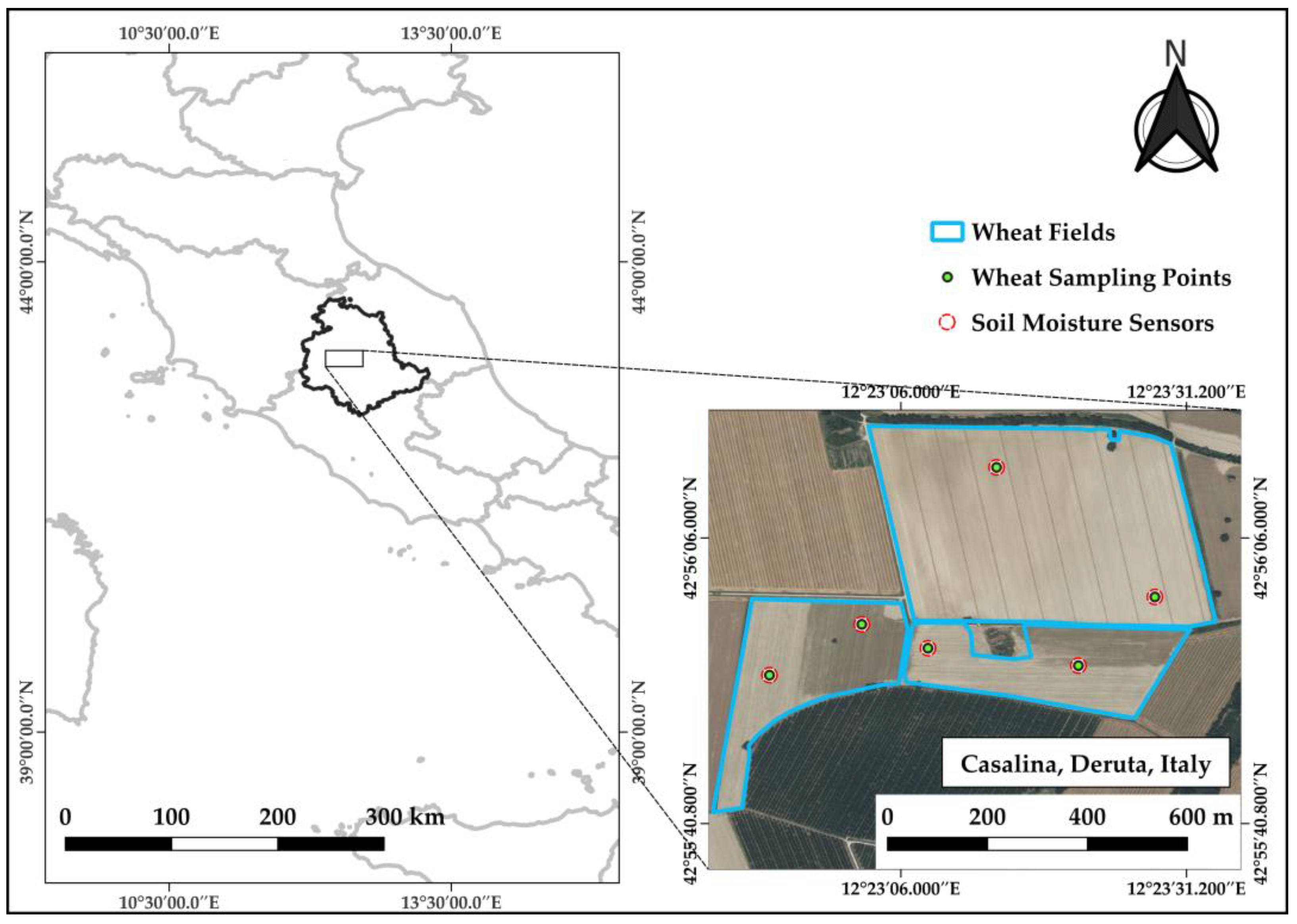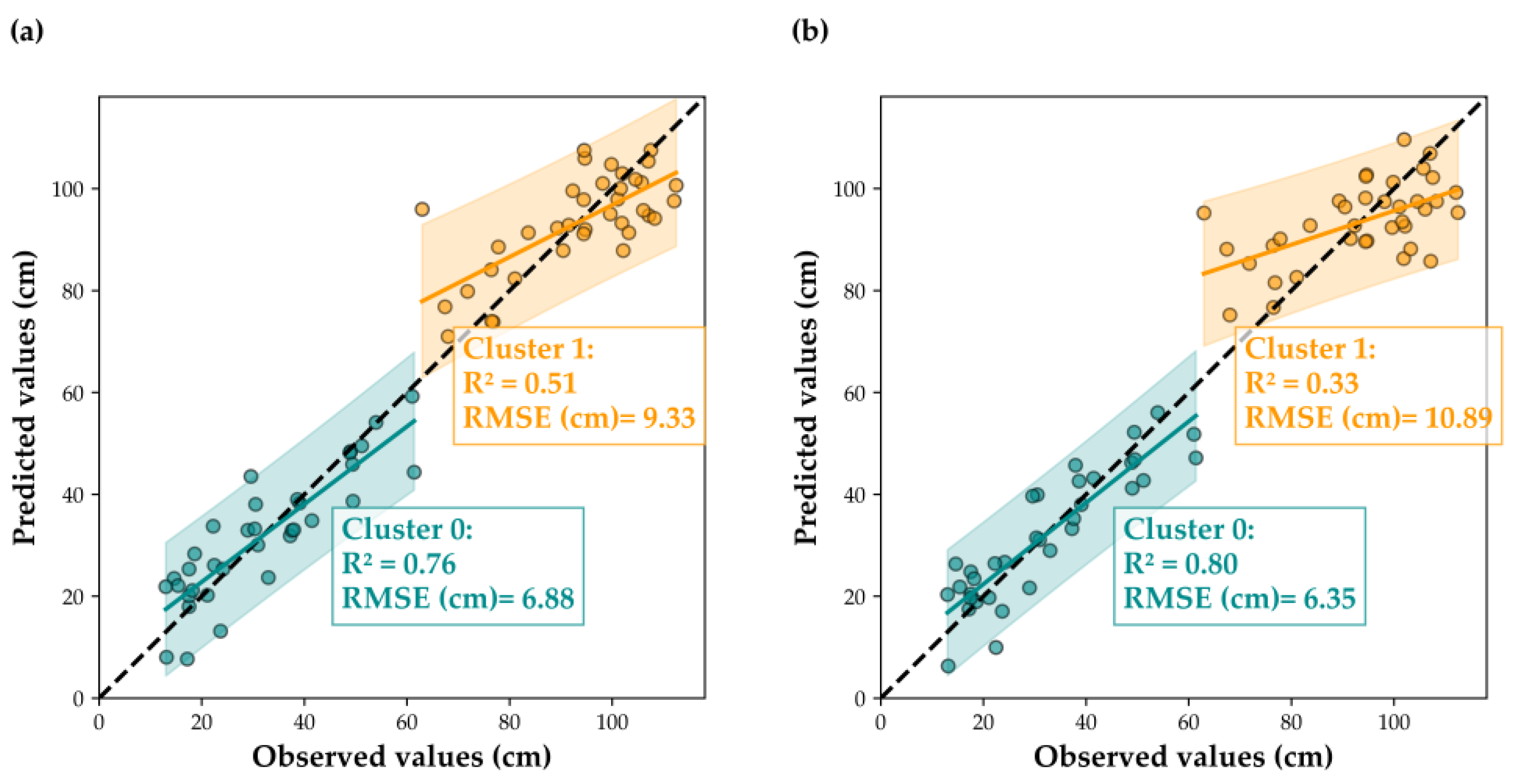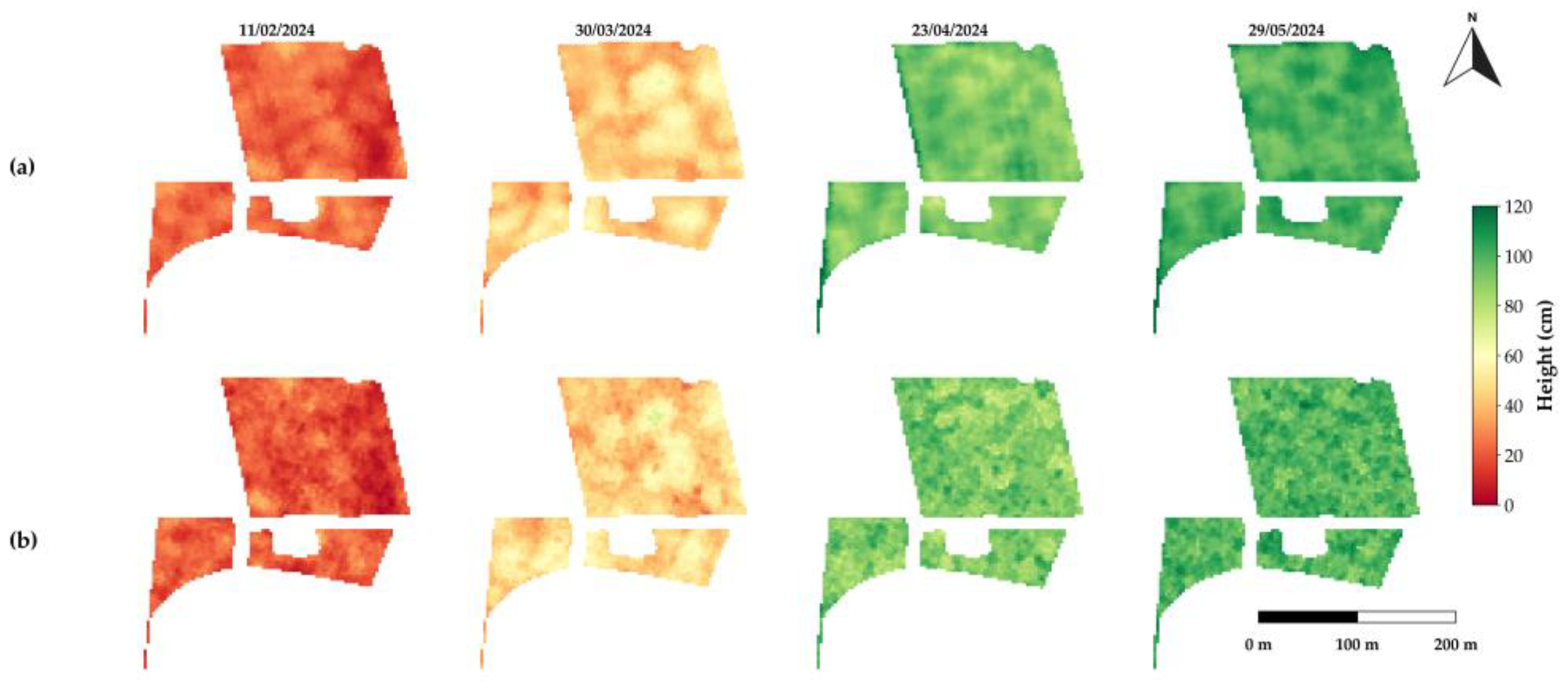Modeling Wheat Height from Sentinel-1: A Cluster-Based Approach †
Abstract
1. Introduction
2. Materials and Methods
- Application of precise orbit file;
- TOPSAR splitting;
- Radiometric calibration to convert integer DN to complex values;
- TOPSAR debursting;
- Generation of polarimetric coherence matrix (C2);
- Multi-looking (four range × one azimuth);
- Polarimetric speckle filtering (Refined Lee 5 × 5);
- Ortho-rectification.
3. Results and Discussion
4. Conclusions
Author Contributions
Funding
Institutional Review Board Statement
Informed Consent Statement
Data Availability Statement
Acknowledgments
Conflicts of Interest
References
- Baraha, S.; Sahoo, A.K. Synthetic aperture radar image and its despeckling using variational methods: A review of recent trends. Signal Process. 2023, 212, 109156. [Google Scholar] [CrossRef]
- McNairn, H.; Shang, J. A review of multitemporal synthetic aperture radar (SAR) for crop monitoring. In Multitemporal Remote Sensing: Methods and Applications; Thenkabail, P.S., Ed.; CRC Press: Boca Raton, FL, USA, 2016; pp. 317–340. [Google Scholar]
- Narin, O.G.; Bayik, C.; Sekertekin, A.; Madenoglu, S.; Pinar, M.O.; Abdikan, S.A.Y.G.I.N.; Balik Sanli, F. Crop height estimation of wheat using Sentinel-1 satellite imagery: Preliminary results. In Proceedings of the ISPRS Archives of the Photogrammetry, Remote Sensing and Spatial Information Sciences, Enschede, The Netherlands, 6–10 May 2024; Volume 48, pp. 267–273. [Google Scholar]
- Jain, S.; Choudhary, P.; Maurya, H.; Mishra, P. Improved crop height estimation of green gram and wheat using Sentinel-1 SAR time series and machine learning algorithms. J. Indian Soc. Remote Sens. 2024, 52, 2887–2899. [Google Scholar] [CrossRef]
- Kumar, P.; Prasad, R.; Gupta, D.K.; Mishra, V.N.; Vishwakarma, A.K.; Yadav, V.P.; Avtar, R. Estimation of winter wheat crop growth parameters using time series Sentinel-1A SAR data. Geocarto Int. 2018, 33, 942–956. [Google Scholar] [CrossRef]
- Nduku, L.; Munghemezulu, C.; Mashaba-Munghemezulu, Z.; Ratshiedana, P.E.; Sibanda, S.; Chirima, J.G. Synergetic use of Sentinel-1 and Sentinel-2 data for wheat-crop height monitoring using machine learning. AgriEngineering 2024, 6, 1093–1116. [Google Scholar] [CrossRef]
- Nasirzadehdizaji, R.; Balik Sanli, F.; Abdikan, S.; Cakir, Z.; Sekertekin, A.; Ustuner, M. Sensitivity Analysis of Multi-Temporal Sentinel-1 SAR Parameters to Crop Height and Canopy Coverage. Appl. Sci. 2019, 9, 655. [Google Scholar] [CrossRef]
- Abdikan, S.; Sekertekin, A.; Narin, O.G.; Delen, A.; Sanli, F.B. A Comparative Analysis of SLR, MLR, ANN, XGBoost and CNN for Crop Height Estimation of Sunflower Using Sentinel-1 and Sentinel-2. Adv. Space Res. 2023, 71, 3045–3059. [Google Scholar] [CrossRef]
- Ghosh, S.; Dubey, S.K. Comparative analysis of k-means and fuzzy c-means algorithms. Int. J. Adv. Comput. Sci. Appl. 2013, 4, 4. [Google Scholar] [CrossRef]
- Meier, U.; Bleiholder, H.; Buhr, L.; Feller, C.; Hack, H.; Heß, M.; Lancashire, P.; Schnock, U.; Stauß, R.; Van den Boom, T.; et al. The BBCH system to coding the phenological growth stages of plants-history and publications. J. Für Kult. 2009, 61, 41–52. [Google Scholar]
- Copernicus Data Space Ecosystem (CDSE). Available online: https://dataspace.copernicus.eu/ (accessed on 24 May 2025).
- ESA. SNAP—ESA Sentinel Application Platform v11.0.0. 2024. Available online: https://step.esa.int/main/snap_11_release/ (accessed on 24 May 2025).
- Filipponi, F. Sentinel-1 GRD preprocessing workflow. Proceedings 2019, 18, 11. [Google Scholar] [CrossRef]
- Harfenmeister, K.; Itzerott, S.; Weltzien, C.; Spengler, D. Detecting Phenological Development of Winter Wheat and Winter Barley Using Time Series of Sentinel-1 and Sentinel-2. Remote Sens. 2021, 13, 5036. [Google Scholar] [CrossRef]
- Cloude, S.R.; Pottier, E. A review of target decomposition theorems in radar polarimetry. IEEE Trans. Geosci. Remote Sens. 1996, 34, 498–518. [Google Scholar] [CrossRef]
- Mandal, D.; Kumar, V.; Ratha, D.; Dey, S.; Bhattacharya, A.; Lopez-Sanchez, J.M.; Rao, Y.S. Dual polarimetric radar vegetation index for crop growth monitoring using sentinel-1 SAR data. Remote Sens. Environ. 2020, 247, 111954. [Google Scholar] [CrossRef]
- Shedthi, B.S.; Shetty, S.; Siddappa, M. Implementation and comparison of K-means and fuzzy C-means algorithms for agricultural data. In Proceedings of the 2017 International Conference on Inventive Communication and Computational Technologies (ICICCT), Coimbatore, India, 10–11 March 2017; pp. 105–108. [Google Scholar]
- Shang, J.; Liu, J.; Poncos, V.; Geng, X.; Qian, B.; Chen, Q.; Dong, T.; Macdonald, D.; Martin, T.; Kovacs, J.; et al. Detection of Crop Seeding and Harvest through Analysis of Time-Series Sentinel-1 Interferometric SAR Data. Remote Sens. 2020, 12, 1551. [Google Scholar] [CrossRef]
- Harfenmeister, K.; Spengler, D.; Weltzien, C. Analyzing Temporal and Spatial Characteristics of Crop Parameters Using Sentinel-1 Backscatter Data. Remote Sens. 2019, 11, 1569. [Google Scholar] [CrossRef]
- Harfenmeister, K.; Itzerott, S.; Weltzien, C.; Spengler, D. Agricultural Monitoring Using Polarimetric Decomposition Parameters of Sentinel-1 Data. Remote Sens. 2021, 13, 575. [Google Scholar] [CrossRef]



| Cluster Group | VH | VV | CR | H | A | α | RVI | |||||||
|---|---|---|---|---|---|---|---|---|---|---|---|---|---|---|
| L | RFL | L | RFL | L | RFL | L | RFL | L | RFL | L | RFL | L | RFL | |
| Tillering–End of Stem Elongation | 0.02 | 0.007 | 0.54 | 0.62 | 0.45 | 0.48 | 0.57 | 0.52 | 0.56 | 0.51 | 0.51 | 0.59 | 0.37 | 0.37 |
| Booting–Development of Fruit | 0.41 | 0.31 | 0.49 | 0.17 | 0.05 | 0.07 | 0.0003 | 0.03 | 0.004 | 0.1 | 0.01 | 0.12 | 0.0009 | 0.0009 |
Disclaimer/Publisher’s Note: The statements, opinions and data contained in all publications are solely those of the individual author(s) and contributor(s) and not of MDPI and/or the editor(s). MDPI and/or the editor(s) disclaim responsibility for any injury to people or property resulting from any ideas, methods, instructions or products referred to in the content. |
© 2025 by the authors. Licensee MDPI, Basel, Switzerland. This article is an open access article distributed under the terms and conditions of the Creative Commons Attribution (CC BY) license (https://creativecommons.org/licenses/by/4.0/).
Share and Cite
Soccolini, A.; Santaga, F.S.; Antognelli, S. Modeling Wheat Height from Sentinel-1: A Cluster-Based Approach. Eng. Proc. 2025, 94, 7. https://doi.org/10.3390/engproc2025094007
Soccolini A, Santaga FS, Antognelli S. Modeling Wheat Height from Sentinel-1: A Cluster-Based Approach. Engineering Proceedings. 2025; 94(1):7. https://doi.org/10.3390/engproc2025094007
Chicago/Turabian StyleSoccolini, Andrea, Francesco Saverio Santaga, and Sara Antognelli. 2025. "Modeling Wheat Height from Sentinel-1: A Cluster-Based Approach" Engineering Proceedings 94, no. 1: 7. https://doi.org/10.3390/engproc2025094007
APA StyleSoccolini, A., Santaga, F. S., & Antognelli, S. (2025). Modeling Wheat Height from Sentinel-1: A Cluster-Based Approach. Engineering Proceedings, 94(1), 7. https://doi.org/10.3390/engproc2025094007







